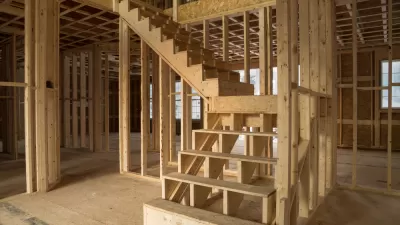Alex Schmidt looks at efforts to re-'train' L.A. drivers to use the city's growing rail network. Planners are focusing on rezoning areas within a 10-minute walk from stations, but face obstacles in blending density with single-family districts.
Encouraging densification around transit stations in Los Angeles is a particularly difficult task due to the city's ubiquitous low-lying residential neighborhoods. Although residents want increased options to the automobile, and voted in overwhelming numbers to support transit investment, many homeowners aren't enthusiastic about adding taller buildings in close proximity to their single-family homes.
"Lots of people live in L.A. because they can have a single family home lifestyle in a city," says Schmidt. "Gen Giuliano is a professor of public policy at the University of Southern California. She says some people may move to preserve that lifestyle, rather than adapt to density."
"But sprawl and long commutes drive other people to dense living. Above this restaurant in the downtown Culver City neighborhood is a stylish, mixed use apartment building. It's about a half mile from an Expo Line stop, and there's a strip of shops just outside the building's front door. This is precisely what city planners hope to create more of in L.A."
"It could take a generation or more for single family home neighborhoods to transform into something like this mixed use area. But the long view is exactly what L.A. planners are taking."
FULL STORY: Rail Planners Aim To Re-'Train' L.A.'s Car Culture

Study: Maui’s Plan to Convert Vacation Rentals to Long-Term Housing Could Cause Nearly $1 Billion Economic Loss
The plan would reduce visitor accommodation by 25,% resulting in 1,900 jobs lost.

Placekeeping: Setting a New Precedent for City Planners
How a preservation-based approach to redevelopment and urban design can prevent displacement and honor legacy communities.

Using Old Oil and Gas Wells for Green Energy Storage
Penn State researchers have found that repurposing abandoned oil and gas wells for geothermal-assisted compressed-air energy storage can boost efficiency, reduce environmental risks, and support clean energy and job transitions.

Washington State Plans Ambitious ‘Cycle Highway’ Network
The state is directing funding to close gaps in its existing bike network and make long-distance trips more accessible.

Homeowners Blame PG&E for Delays in ADU Permits
The utility says it has dramatically reduced its backlog, but applicants say they still face months-long delays for approvals for new electrical work.

Rethinking Wildfire Defense: How a Landscape Approach Can Protect Neighborhoods
Post-fire analysis of the Eaton Fire reveals that a landscape approach — including fire-resistant vegetation, home hardening, and strategic planning — can help reduce wildfire risk, challenging assumptions that trees and plants are primary fire hazards.
Urban Design for Planners 1: Software Tools
This six-course series explores essential urban design concepts using open source software and equips planners with the tools they need to participate fully in the urban design process.
Planning for Universal Design
Learn the tools for implementing Universal Design in planning regulations.
Borough of Carlisle
Caltrans
Heyer Gruel & Associates PA
Institute for Housing and Urban Development Studies (IHS)
City of Grandview
Harvard GSD Executive Education
Salt Lake City
NYU Wagner Graduate School of Public Service
City of Cambridge, Maryland



























